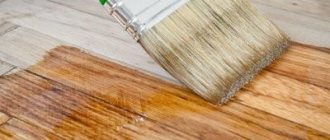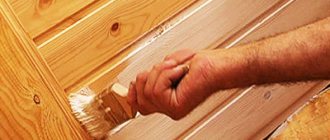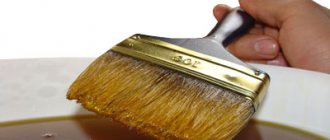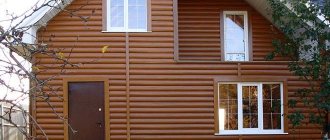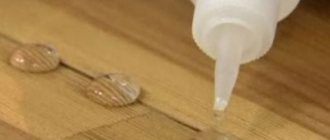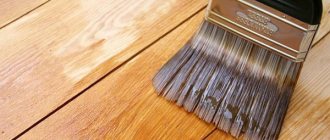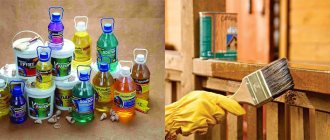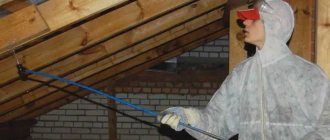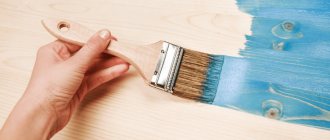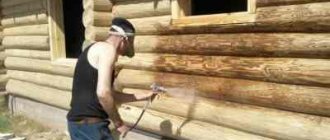Used oil as protection for wood
People quickly figured out using used motor oil to process wood. It protects the surface of the structure from the negative effects of moisture. It is used to protect warehouses, fences, garages, hangars and other industrial facilities.
Processing wood that has already been damaged protects the structure from subsequent destruction and rotting. Most often they cover the part of the fence that is in contact with the ground. For wood that is already damaged, there is practically no better protective substance to be found.
Among the various compositions used as antiseptics, tar and linseed oils are distinguished. The features of the first type are as follows:
- Strong antiseptic, suitable for insulating the bottom of piers and boats. The surface treated with tar lubricant retains its structure. The substance itself cannot be diluted.
- Easy to apply. The flax base is suitable for household use and impregnation of log buildings.
Linen acts as a strong waterproofing agent. Based on them, a large number of impregnations are produced for the facade and foundation of buildings.
Is it possible to use “working off” to impregnate wood?
All owners of wooden structures and buildings are aware of the need to use special protective agents, such as fire retardants and antiseptics, for wood.
Since wood is a “living” material, it will indeed very quickly become unusable without treatment with protective compounds. The rate at which wood deteriorates depends on what will destroy it faster. Rot, pests, mold, external biological and physical influences, diseases. But in any case, corrosion will occur very quickly.
One of the well-known, “folk” ways to protect wood from external influences is used machine oil or “waste oil”. Will such a product really protect wood and is it worth using?
There are a lot of opinions on this matter. This method of impregnation has many supporters and opponents.
Pros and cons of wood oil
Without special treatment, wood does not last long; moisture causes mold and rot, reduced strength and deterioration in appearance. Processing wood with a lubricating fluid is characterized by the following advantages:
- Kills mold, protects the structure from attack by pests. Due to this, it becomes much stronger and lasts longer. To increase the service life of wooden load-bearing buildings, they are often impregnated with waste oil.
- The wood is coated with waste oil to eliminate the possibility of moisture entering the structure. That is why after treatment you can reduce the likelihood of rot.
- In most cases, there is no need to buy waste, since many car owners simply throw it away. Used oil diluted with fuel or water will not work.
- The wood is protected not only from rotting, but also stops the destruction of damaged areas.
- The advantages include the possibility of long-term storage and application without the use of special tools.
You can process wood in this way yourself. However, when choosing engine oil, you need to consider several disadvantages:
- “Working off” prevents rotting, but at the same time greatly spoils the appearance of the product. The thick consistency absorbs into the structure for a long time and gets dirty when it comes into contact with it. Some problems can be solved by warming up the used waste oil a little.
- The common synthetic group of lubricants contains many toxic and carcinogenic elements. If they evaporate, they can negatively affect human health. This leaves a persistent unpleasant odor. Therefore, this treatment method is not used for treating residential or heated premises.
- Wood on the surface of which a lubricant has been applied cannot be further processed; it is not possible to apply paint due to a decrease in the degree of adhesion. This kind of work is often the final stage.
- The types and methods of production differ significantly; mineral ones have practically no pungent odor, but today they are used much less frequently.
- Color and texture cannot be preserved. Therefore, they are not used to cover wooden decorative elements. It is no longer possible to restore a surface treated with used machine oil. Used oil penetrates deep into the structure, changing the basic qualities.
There is no clear answer to the question of whether it is worth using “recycling” to protect natural material. It is not recommended to use lubricant from heavy equipment or transmission, since the concentration of harmful substances and poisons in them is very high. Some pros and cons must be taken into account with the characteristics of the specific part or surface that will be processed.
Possible wood processing products
The technology for impregnating wooden sleepers for railway tracks involves treatment with creosote, simply tar oil. In addition to it, other wood processing is possible using the following substances:
- wax mixed with solvent;
- linseed oil, which contains a solvent;
- drying oils;
- used machine oil.
Composition for wood impregnation.
There is a lot of controversy about the latter. Oil used in industrial areas and heavy equipment is especially dangerous. Another option is to use motor oil from passenger cars. After just a few days, it loses its pungent odor and destructive properties. Undoubtedly, this substance, as an oil-based machine impregnation, can be used exclusively for treating non-residential wooden premises. For example, sheds, warehouses, various wooden buildings, wells, attic elements and other structures. Experienced carpenters have long been treating hidden elements of buildings with oil, such as rafters, ends and ceilings of beams, undersides and joists of floors and partitions of walls going under the cladding.
It is worth treating wood with waste oil precisely in those places where there is a high possibility of the wood coming into contact with the ground, where the log house has open surfaces that will subsequently suffer greatly from external temperature and other influences, for example, near the roof or foundation.
We clean the waste ourselves
Wood that is coated with motor oil can last for a long period. If necessary, the lubricant can be cleaned of harmful elements yourself at home in several stages:
- The “working” is merged due to the fact that a large number of large fractions enter the composition. To remove them, you need to let the used oil sit for 10-12 days. During this period, all large elements will fall to the bottom, forming sediment. After this, the liquid part is drained.
- Chemical cleaning. You can use motor oil for processing wood with minimal damage to the wood structure by adding coalifying agents (zinc chloride, liquid glass, heavy metals) to the composition. After this, the container is thoroughly shaken, and the resulting mixture is allowed to stand for 3 days.
- Mechanical cleaning. To remove large impurities, sand filters or a special synthetic fabric can be used. Processing wood without pre-cleaning it reduces the effectiveness of the procedure.
The prepared composition is quickly absorbed into the wood structure. It is recommended to store it in an airtight container.
Popular substances for impregnation
Popular “folk remedies” include:
- clay coating;
- copper, iron sulfate;
- drying oil
Let's take a closer look at them. The first is a protective layer of clay, ordinary salt and water. This composition is coated with a 2 mm layer of wood. There is also an option for a mixture of superphosphate and water, which is applied to the wood in a layer of 3 mm.
This coating really protects against external influences and helps the tree maintain its integrity. There is only one question - who would want to coat the beautiful facade of a house or an elegant wooden gazebo with clay? And even more so the wooden walls from the inside of the house?
This option is only suitable for outbuildings, such as a barn. And, in general, this was relevant on the scale of active construction of state and collective farms in Soviet times, and aesthetics and durability were always in question.
Another method is to treat wood with copper or iron sulfate. These are metal salts that work well as antiseptics. But vitriol is dangerous to health: if it comes into contact with the skin, eyes, or nose, it leads to choking, coughing, abdominal pain, swelling and lacrimation. If the wood treated with it begins to burn, the inhaled combustion products will lead to serious burns of the mucous membranes. Such impregnation is unsafe for humans.
And you shouldn’t use vitriol as a façade finish either:
- It makes the wood darken and turn gray. If you want to leave the natural texture and color, then this composition will ruin everything. Vitriol, of course, will not work for facades, gazebos, or staircases in the house.
- If there are galvanized metal parts, then the vitriol will “remove” the zinc layer.
- You cannot work with vitriol in wet weather, and for a couple of days after “painting” it should be dry and warm.
- In rainy weather, such a wall will be “smeared”.
The vitriol mixture is good for “technical” boards, such as beams and joists (when installing a roof or laying a floor). That is, these can be elements hidden from view, where aesthetics, color and texture are not important, but integrity, invulnerability and durability are significant.
Even more often, wood is treated with drying oil, arguing that it is natural linseed oil.
Indeed, in theory, technical linseed oil is considered drying oil. However, in stores, bottles labeled “Drying Oil” often sell a mixture of synthetic and vegetable oils.
This composition is worse than natural linseed oil. He:
- dries poorly and does not form a durable film;
- clogs wood pores - does not allow the wood to “breathe”, increases the risk of mold due to mustiness inside the log house;
- often contains lead compounds, so surfaces in residential areas cannot be treated with this composition.
Therefore, drying oil from the store is far from the best option for impregnation. It is suitable for treating garden furniture, fences, technical buildings for further painting. If you are planning to impregnate the facade or walls of your house, then carefully read the composition, look for technical linseed oil, or simply buy edible linseed oil in the supermarket and work with it.
Painting with machine oil
Before the actual procedure, you need to prepare all the required tools and parts. They are as follows:
- Used motor oil. Before direct use, it must be mixed thoroughly. The used composition should not have large impurities or other liquid inclusions.
- Latex gloves. At the time of using the antiseptic in question, exposed skin should be protected.
- Cotton cloth, sandpaper. Wood protection should be carried out after preliminary surface preparation.
- Rollers, brushes, sprayer. There are several ways to apply used oil. Processing wood manually is most often carried out using a roller, since with this tool it is easier to distribute the substance evenly. It is worth considering that the tools used will be unusable in the future.
When using oil as an antiseptic, you need to thoroughly saturate the structure. The whole procedure can be divided into several stages:
- Preparation. After cleaning the oil, you need to clean the surface to be treated from dust and other contaminants. The use of special degreasers will improve the quality of the final result.
- The machine lubricant can be slightly heated, which will speed up the absorption and drying process. It is easier to treat the surface with warm oil due to its increased fluidity.
- If you need to cover a large area, you can use a sprayer or roller. Small parts and elements are impregnated with a brush. During work, debris and other foreign elements must not be allowed to enter.
- It takes several hours or days to dry. Therefore, when treating a facade or foundation, you should wait for dry weather.
It takes quite a long time for wood to dry. Used engine oil is considered an excellent impregnation agent, which is associated with relatively high efficiency and low cost.
When choosing used oil, do not forget that this composition is characterized by high flammability. Therefore, in some cases it is recommended to use special compounds for impregnation and protection of wood, for example, when treating the walls of a residential building, large residential or industrial structures.
The nuances of waxing
Another popular ingredient is wax. It is also good, but it has a significant drawback - it is only suitable for interior decoration, since it does not tolerate high temperatures, heat and is easily removed from the surface.
In modern house construction, only wooden floors are treated with wax, since waxing is a long and painstaking job that requires subsequent rubbing of the surface with oil. The materials can be either self-made (molten wax and then linseed oil) or factory-made (now they are produced by manufacturers from the USA, Germany and Turkey). All this is expensive and difficult, so it is advisable to treat parquet and expensive furniture with wax.
Let's look into it in detail. Let's start with the positives
- Extraction, like any other oil, will perfectly protect the tree from mold, pest attacks, and rot. It will also strengthen the wood and extend its service life.
- Used engine oil has excellent water-repellent properties and no cost. You don't need to buy it. Either dispose of it or saturate the wood.
- “Working out” will help stop the destruction of already damaged wood
That's it, we're done with the positives. What disadvantages can there be with such a list of advantages? You ask.
What to prefer?
Of course, the ideal option is to purchase special antiseptic moisture-proof impregnations for wood from a reliable manufacturer. Factories produce the same natural oils with additives that improve the properties of the product.
We will give some recommendations for choosing store-bought impregnation:
- All wood impregnations that are put on the market must comply with BPD (Bioceds Product Directive) standards, that is, they must be biologically pure, environmentally friendly products. Not all domestic manufacturers have such a certificate, but you can also take a closer look at those products that do not have such a guarantee. True, there are risks in terms of service life.
- For wood, it is better to purchase acrylic impregnations and water-based compounds - they will give the wood the opportunity to “breathe”. Rough solvents clog pores and, in fact, create a risk of rotting.
Features of painting an old fence
The old fence is painted in the same way as the new one. With the exception of preparation - here it must be thorough.
Old paint is removed with a brush or metal paper. There are solvents that are applied to a rag and wiped off the dried paint. All processes are performed using rubber gloves. If some of the boards are eaten by insects, then it is better to replace them.
Old varnish is removed in the same way. The cracks are primed and puttied. Afterwards the fence is painted.
The choice of product is individual. The main condition is high-quality protection of treated wood for decades without losing its attractive appearance.
Structures and buildings made of wood are more susceptible to the negative effects of sunlight, precipitation and other weather conditions than other materials. To prevent wood destruction, these parts must be protected using special wood treatment products. One such product that performs a protective and water-repellent function is used machine oil. Treatment with used machine oil is a unique tool that helps protect wood from rot, mold and other unpleasant problems that destroy boards.
Wood processing requires caution and study of the final goal, thoughtfulness of how the wooden structure should turn out in the end. If it is necessary to change the color of wood, for which various protective or painting agents are used, such work with wood requires a different approach if the treatment is carried out indoors or outdoors.
For working with wood, there are many different materials that can protect wooden parts, paint them or varnish them.
For wood processing the following are used:
Impregnation (determining the required material) for a wooden structure or part is selected based on the type of wood, its purpose in the building or the final color option.
A folk remedy invented by scientists
If you really want to make impregnation yourself, you should turn to proven methods. In Soviet times, in the Senezh Wood Conservation Laboratory of the TsNIIMOD Ministry of the Forestry and Woodworking Industry of the USSR (yes, it’s a long read), a safe composite “BB-11” was developed - it is harmless to humans, protects against biological damage and does not change the color of wood, since it was originally developed for restoration valuable wooden objects in Karelia. It is prepared as follows:
- 173 g of technical borax;
- 173 g boric acid;
- 3,094 liters of water.
This is a composition for processing 1 square. m. From a mixture of borax salts and acid, you need to prepare a 10% aqueous solution, and before applying, heat it to 40 0 C. Apply the mixture with a soft brush to the wood - either seven times, or after a single application, cover the treated surface with polyethylene, securing it with push pins. Of course, if this is a facade, you won’t have enough polyethylene; you will have to process it in seven layers (you don’t need to wait for the previous layer to dry). This product meets all the requirements and at the same time can be considered a “folk” recipe.
In the second half of the last century, in conditions of total shortage, craftsmen used used machine oil, which had served its purpose, for the protective impregnation of wood. The solution was a success; this method of using waste oil became widespread. Suppliers of used protective fluid were enterprises that owned cars, river vessels, diesel generators and other equipment. Officially, such a product did not exist; the workings were not supplied to the trading network.
Waste is a product resulting from the operation of internal combustion engines. The oil fluid in the engine operates under extreme conditions at elevated pressure and high temperature, under these conditions the product acquires new properties that allow it to be used as a wood impregnation with water-repellent and antiseptic properties. Currently, mining has become a commodity; the product is purified in special installations, and after removing harmful impurities, it goes on the market as an impregnation for construction wood.
